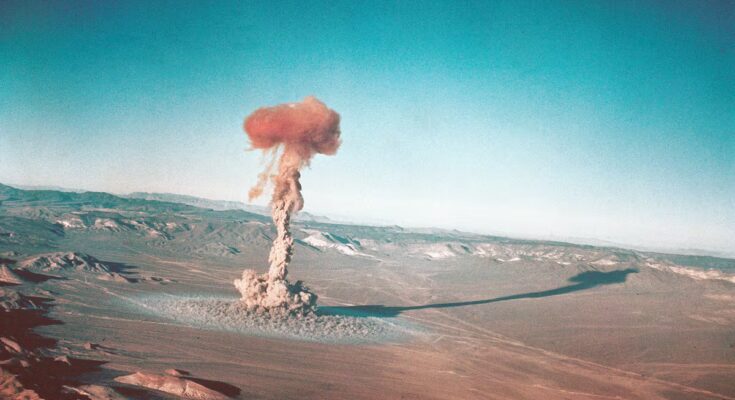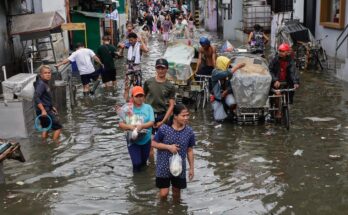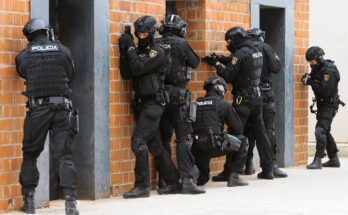Minutes before meeting with Xi Jinping in Busan, Donald Trump said he had ordered the US Department of War (Defense) to “immediately” resume nuclear weapons testing. The announcement sparked a mix of alarm and confusion among the negotiating team that had traveled with the Chinese leader to the South Korean city, as well as to Beijing, Moscow and even Washington. The US president hinted that the world’s leading power will detonate atomic bombs again – a practice only North Korea has carried out this century – just hours after Vladimir Putin boasted of successfully testing a nuclear-powered underwater drone capable of devastating entire cities. All this, a few months after the expiration of the last treaty which still places limits and restrictions on the atomic arsenals of the United States and Russia, and before the era of nuclear control created during the Cold War definitively ends.
The text that Trump published on October 30 on Truth, the social network he owns, while on his way to the meeting with Xi was ambiguous and contained numerous falsehoods. “The United States has more nuclear weapons than any other country,” the message began., although Russia has more; He also lied when he said Beijing will have as many nuclear warheads as Washington “in five years.” The Republican claimed that in his first term “a complete upgrade and renewal” of American atomic bombs was achieved, although the truth is that the Pentagon is about to launch the first major plan to modernize its nuclear arsenal since the Cold War, a project whose origins date back to Barack Obama’s administration and in which a trillion dollars (the equivalent of Switzerland’s GDP) will be invested over the next decade.
First of all, Trump’s publication from Busan raised many doubts as to whether the president was referring to the resumption of nuclear tests, on which there is a moratorium. in fact for more than 30 years, or if he was just talking about testing strategic atomic weapons delivery systems.
Trump was less ambiguous a couple of days later, when asked during a television interview whether what he had ordered to resume were nuclear tests in the strict sense; that is, the United States detonated atomic bombs for the first time since 1992. “What I’m saying is we’re going to test like other countries, yes,” he told CBS from his golf club in Florida, before boasting that he could “blow up the world 150 times” with America’s arsenal. “Doesn’t it seem logical to you? You make atomic weapons and then you don’t test them. How do you know if they work? We have to do it,” the president said, before accusing Russia, China and Pakistan – as well as North Korea – of carrying out secret tests with atomic bombs – “they don’t talk about it and there are no journalists there to tell it”, he argued. “We are the only country that doesn’t test,” Trump said.
Beijing, Moscow and Islamabad responded promptly to Trump’s accusations and assured that they were respecting the informal moratorium that has banned nuclear tests since the late 1990s. On the same day, Chris Wright, US Energy Secretary, tried to dampen alarm by saying that “the tests ordered by President Trump” do not include “nuclear explosions”. “The planned tests cover all components of a weapon to verify that they configure the correct geometry to trigger the explosion,” Wright told Fox News.
Daniel Salisbury, a researcher at the International Institute for Strategic Studies, believes it is “very unlikely” that Washington will resume underground atomic bomb explosions. “In theory, the United States retains the ability to conduct a nuclear test within 36 months. However, reopening the Nevada National Security Site (where nearly a thousand atomic tests have taken place over the past century) would be an extraordinarily controversial, long, and expensive process,” Salisbury argues.
The incendiary announcement that Trump made from Busan, more than a message to China, also seemed to be a response to the veiled threats against the United States that Putin had launched a few hours earlier. The Russian president, during a visit to a military hospital in Moscow, declared that “another invincible Russian weapon” had just been tested: the Poseidon torpedo, a nuclear-powered underwater drone designed to travel thousands of kilometers and cause a sort of radioactive tsunami capable of devastating coastal cities. “Its power far exceeds that of our most advanced intercontinental ballistic missile,” the Russian autocrat said, surrounded by wounded soldiers in Ukraine. Putin stressed that the Poseidon “is unique in the world” and that attempting to intercept it would be an “impossible” mission.
A few days before boasting about the alleged success of the Poseidon test, the Russian president informed some senior military commanders, during a televised meeting, that “decisive tests” of the Burevestnik had been completed: a nuclear-powered cruise missile capable of carrying atomic warheads and, according to Putin, “with an unlimited range”. Both the Poseidon and the Burevestnik are strategic weapons of mass destruction, designed to strengthen Russia’s deterrent capability and be used only in the event of a nuclear attack.
Tests by the Russian military with its most modern weapons are not uncommon. Nor is it exceptional that the Kremlin flaunts them. In 2018, in his state of the nation speech, Putin already boasted of the “six invincible weapons” under development, including the Poseidon torpedo and the Burevestnik – a missile “with an unpredictable trajectory and, therefore, capable of evading US missile defense systems,” he later stressed.
More significant is the moment chosen by the Russian president to announce the success of the tests of the Poseidon and the Burevestnik. After a few months of frenetic diplomatic activity, in which Trump seemed convinced he could bring Putin and his Ukrainian counterpart, Volodymyr Zelenskyj, to the same table to negotiate, the American president’s determination to end the war between the two former Soviet republics seems to have cooled. Just days before the Russian president praised the capabilities of the Poseidon and Burevestnik, the White House canceled the planned meeting between Putin and Trump in Budapest, and the American government imposed sanctions on Lukoil and Rosneft, two giants of the Russian oil industry.
Nuclear blackmail as an instrument of pressure
With the large-scale invasion of Ukraine begun by Russian troops in February 2022, tanks and trenches returned to the Old Continent, as did nuclear blackmail to intimidate Kiev’s allies. Most analysts agree that the Kremlin’s praise for its atomic arsenal, rather than threats, should be interpreted as a tool of diplomatic pressure; a way to remind the West – especially Washington – that if Russia felt cornered and unable to achieve its goals in Ukraine, the risk of a nuclear apocalypse would increase.
After Trump’s brazenness in South Korea, the Kremlin reacted quickly. “If the US president somehow refers to Poseidon and Burevestnik, these (tests) cannot be considered nuclear tests under any circumstances,” presidential spokesman Dmitry Peskov told the Tass agency. After Trump claimed in his CBS interview that Russia is carrying out secret tests with atomic bombs, Putin flatly denied the accusation, but warned that the Eurasian country will again carry out tests with weapons of mass destruction if Washington takes the first step.
The increased use of nuclear rhetoric comes less than four months before the expiration of the New Strategic Arms Reduction Treaty (New START), the last existing bilateral agreement that places limits on the atomic arsenals of Russia and the United States. Other pillars of this arms control structure – such as the Intermediate-Range Nuclear Forces Treaty, signed by Ronald Reagan and Mikhail Gorbachev in 1987, or the Anti-Ballistic Missile Treaty, agreed between Richard Nixon and Leonid Brezhnev in 1972 – have been falling apart for years.
Negotiate with China
Faced with the imminent end of a security agenda crafted by Washington and Moscow for more than 50 years, Trump insists that any future arms control pact must include China. Beijing shows no interest in these talks and claims that its atomic arsenal is very small compared to that of the United States. In July 2024, Xi’s government suspended all contacts with Washington regarding arms control following the sale of several North American air defense systems to Taiwan.
About 90% of the 12,240 atomic bombs that the Federation of American Scientists estimates exist around the world are stockpiled in the arsenals of Moscow and Washington. The other seven nuclear powers (China, France, the United Kingdom, Israel, India, Pakistan and North Korea) number just over a thousand. The Pentagon estimates that China has 600 nuclear warheads and estimates it will have more than 1,000 by 2030.
When New START – signed by Obama and Dmitri Medvedev in Prague in 2010 – expires in February, it will open the door to a period of uncertainty. “The absence of agreed limits will increase mistrust and increase the risk of misunderstandings and miscalculations,” summarizes Georgia Cole, a researcher at the British analysis center Chatham House. “Unfortunately, given the current geopolitical tensions, it is very unlikely that a new nuclear control treaty will be signed in the short term,” predicts the expert.
Paradoxically, it is Medvedev, the current vice-president of the Russian Security Council, who has resorted most to nuclear blackmail since the beginning of the invasion of Ukraine. In September, the former Russian president warned European leaders that if they made “the mistake of triggering a conflict” with Moscow, it would turn into “a war with weapons of mass destruction.” Medvedev added that the end of the era of nuclear control marks the beginning of “a new reality that Russia’s enemies will have to deal with.”
While a few weeks ago in Washington they were discussing the possibility of sending long-range Tomahawk missiles to Ukraine, with which Kiev could hit targets in Moscow and St. Petersburg, Medvedev directly threatened the president of the United States: “The delivery of these missiles could end very badly for everyone and, first of all, for Trump himself.”
The risks of a new nuclear arms race are not limited to the arsenals of Russia, the United States and China. “Relations between India and Pakistan remain very tense and unstable, and North Korea continues to make progress in developing nuclear weapons,” Cole points out. The Chatham House researcher points out that “despite the US and Israel’s assurances that the (June) bombing of Iran’s nuclear facilities was very effective”, it appears that the Islamic Republic “still retains some of its capabilities”.
In case the ingredients to fuel the controversy in Washington over atomic weapons were missing, he was released a few weeks ago A house full of dynamite, a drama directed by Kathryn Bigelow that plays with the idea of an imminent nuclear attack on the United States. As an example of the discomfort generated at the Pentagon, an internal document of the Missile Defense Agency, to which he had access Bloomberg, claims that the catastrophic scenario presented in the film “is inaccurate” and criticizes that the fictional representation “underestimates the power of US defense systems”. Noah Oppenheim, the screenwriter of A house full of dynamite, He told CNN that his intention was precisely “to generate a debate on a crucial issue that does not receive the attention it deserves: the existence of so many nuclear weapons in the world and the enormous danger they pose to humanity.”



